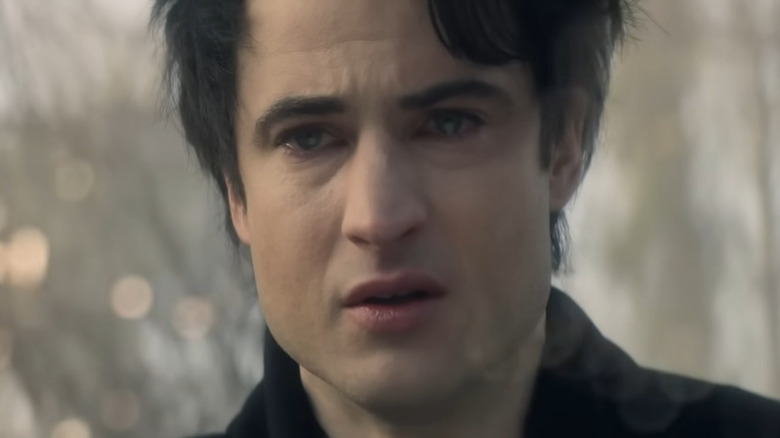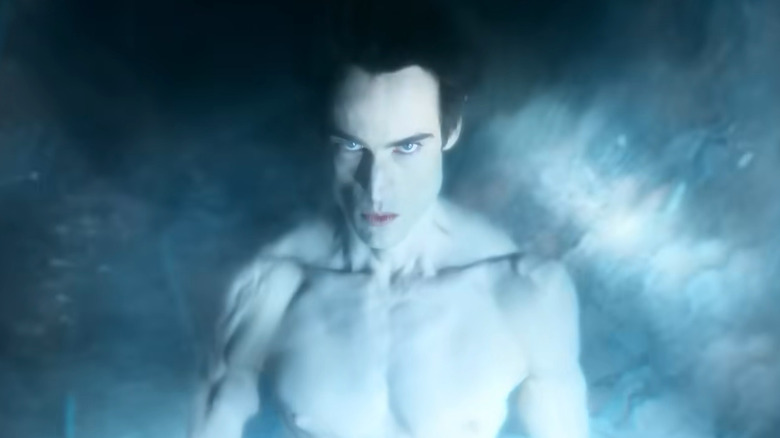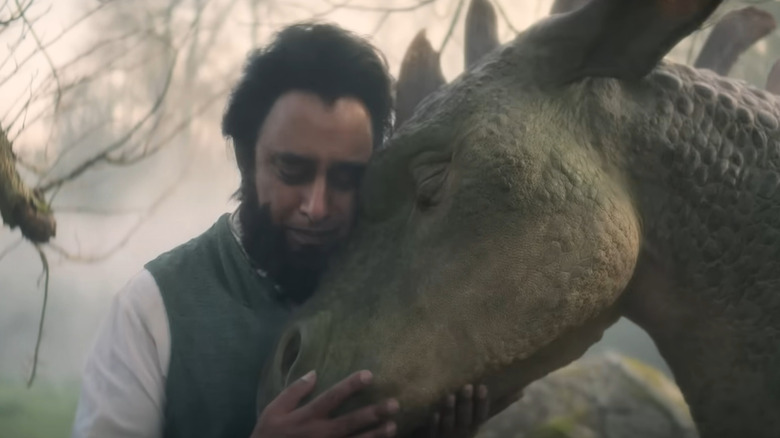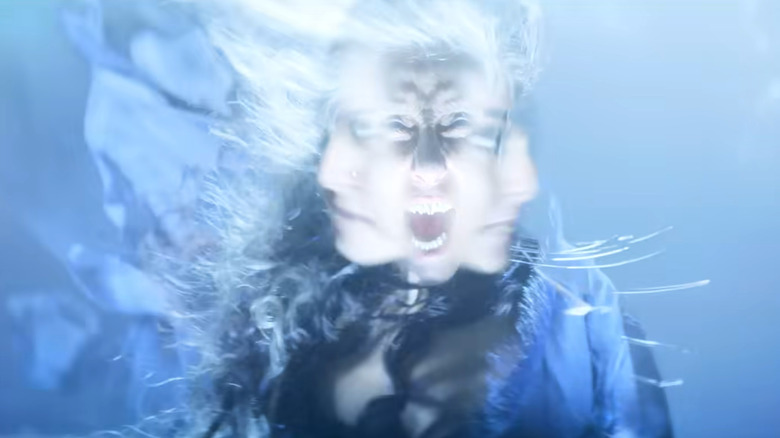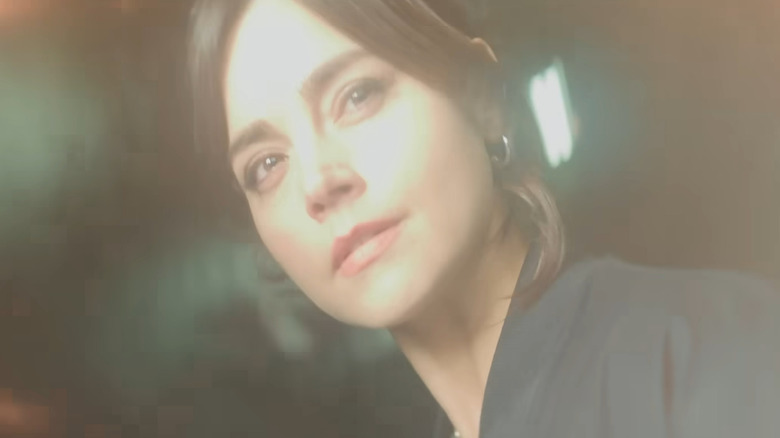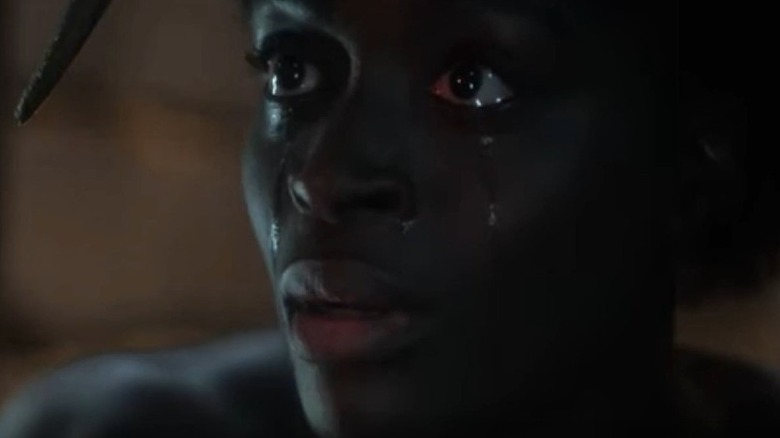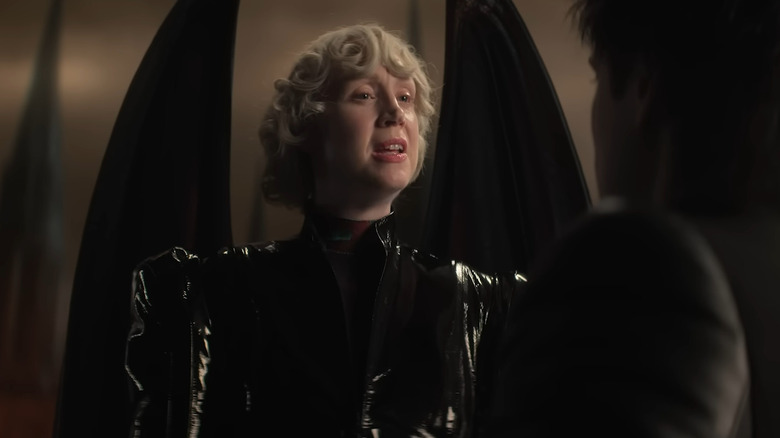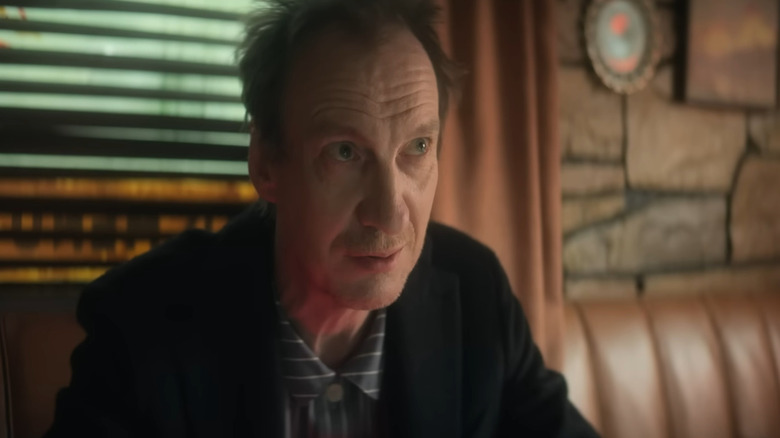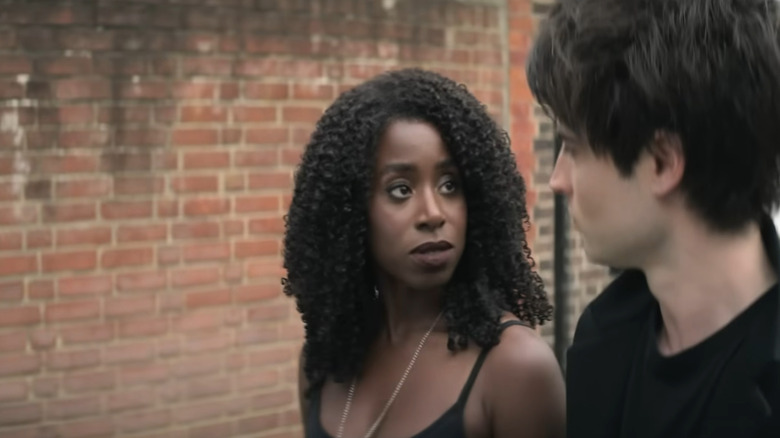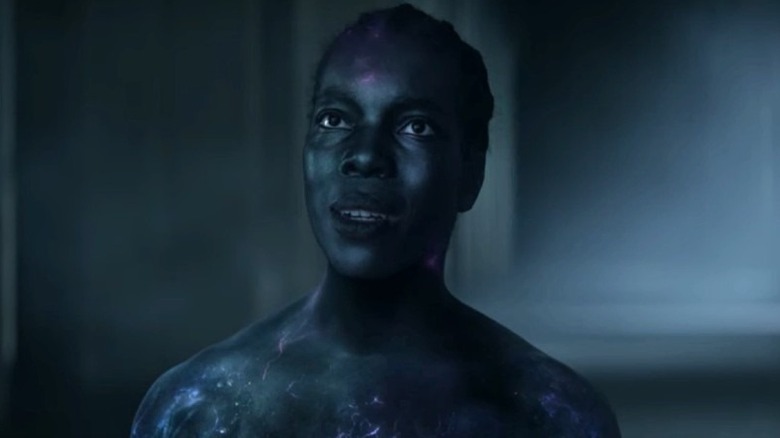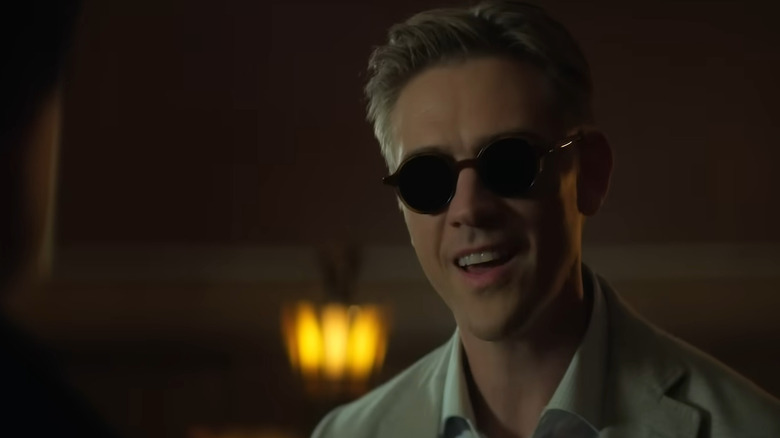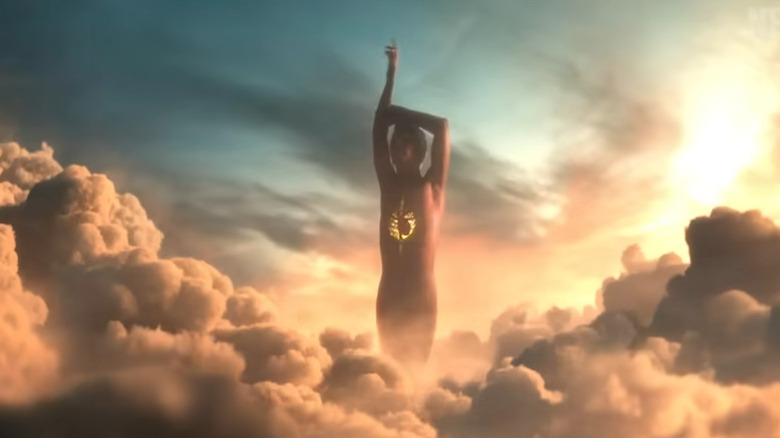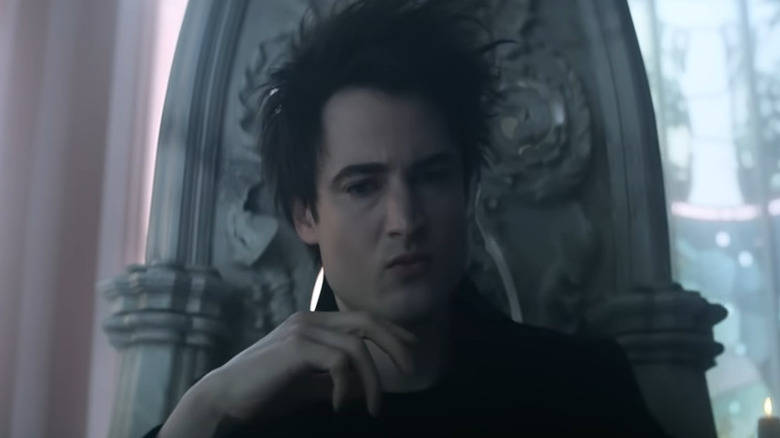The Most Confusing Moments In The Sandman Season 1 Explained
Netflix's "The Sandman" is big, bold, and frequently baffling. It's a fantasy epic that spends just as much time on small human moments as it does on mythical lore. Based on the acclaimed comics by Neil Gaiman, "The Sandman" is a series that comprises many tones and genres, resulting in a story that's frequently powerful and occasionally messy.
Of course, some level of confusion is inevitable when your main character is the personification of dreams. Lord Morpheus (Tom Sturridge), as he's called by those who occupy his realm, is a larger-than-life protagonist who struggles equally with apocalyptic events and basic social relationships. His world is inhabited by a myriad of other characters ranging from human occultists and waking nightmares to adorable gargoyles and the literal Devil. It's an odd bunch to be sure, but "The Sandman" is an odd show — one filled with twists, turns, and half-told stories.
Much of the mythos on which "The Sandman" is built is only partially explored in Season 1, and as a result, there are a lot of moments that may feel confusing to those who haven't read the comics. There also some big changes and brand-new additions that shake up the existing lore, but because of the show's breakneck pace and sprawling scope, they're not always easy to understand. These are the most confusing moments in "The Sandman" Season 1 explained. Be warned, there are major spoilers ahead.
The ritual to imprison the Sandman
The first episode of "The Sandman" is a wild ride that spans over 100 years, and it features a lot of scenes that happen so quickly you'd be forgiven for not fully understanding them. Before we even get to know Morpheus, he's sucked into a magical prison by the occultist Roderick Burgess (Charles Dance) and his disciples. Burgess' motivations are clear — he wants to compel Death to return his son who was killed in World War I. Unfortunately for Burgess, he ends up trapping Death's brother instead.
Because the episode moves so quickly, Burgess' whole arrangement can be a bit confusing. What's the deal with his cult of followers, his incredibly public persona, and his immense wealth? While Burgess is a fictional character, he's described in the show as a peer of Aleister Crowley, a real British occultist who gained immense fame in the early 20th century. Like Burgess in "The Sandman," Crowley built a massive public profile despite the questionable nature of his work. He eventually experienced a major fall from grace after details of some of his alleged rituals made their way to the public ear, as chronicled by Ozzy Osbourne.
As for Burgess' ritual itself, the items used and incantation recited fall well in line with various traditions of ritual magic. The idea of a magic circle being used to summon and contain Dream will be familiar to fans of the genre, and it pulls from the real occultism that inspires the story.
Cain and Abel
If you haven't read the Bible, the appearance of Cain (Sanjeev Bhaskar) and Abel (Asim Chaudhry) in "The Sandman" might be pretty confusing. Even if you are familiar with their biblical story — they're the first sons of Adam and Eve and become the first murderer and the first victim, respectively — their role in Gaiman's fantasy world isn't entirely clear.
In the comics, Cain and Abel's story is still a bit fuzzy, but there's at least a little more exposition that isn't present in the show. Though Morpheus generally frowns on the idea of ghosts staying in the Dreaming, it's suggested that he brings the brothers to live there after making a deal with his sister Death. Their role is to repeatedly act out their story — one of the first — which results in Cain killing Abel over and over again, and Abel rising from the grave each time.
While both the comics and Netflix's "The Sandman" pull heavily from the Bible, Gaiman's world is different in many ways. As such, it's hard to deduce too much about his renditions of Cain and Abel based on the source material. The live-action series doesn't even officially confirm that its brothers are the real deal and not recreations made by Dream. However, given how much of their story is kept exactly the same as it is in the comics, it seems safe to assume that their backstory hasn't changed.
Dream's encounter with the Fates
Upon his return to the Dreaming, Morpheus quickly sets about finding his stolen tools — his helm, pouch of sand, and ruby. To find out where they are, he enlists the help of the Fates — three beings who take the form of human women when he speaks to them. A great deal of effort goes into summoning them, and even once Dream's audience is granted, the Three (as they are also called) prove to be incredibly cryptic.
While they are referred to as the Fates in "The Sandman," these three supremely powerful beings are far more than that. As Morpheus mentions, they are connected — one single being of three parts, but also three different beings who form a greater whole. They have many identities in the comics — the Fates, the Furies, and the Kindly Ones, among others. This is Gaiman's way of incorporating multiple different legends into a single "character" using the longstanding "Triple Goddess" myth to explore different faiths and superstitions at the same time. When the Three appear to Morpheus, they take shape as the Maiden, the Mother, and the Crone — the traditional forms of the Triple Goddess.
In the comics, the Three ultimately prove themselves to be far more dangerous than even Dream suspects. It remains to be seen if they'll take on more action in the show, or if they'll remain in the background indefinitely.
Johanna Constantine's dream
Jenna Coleman's Johanna Constantine — a gender-bent version of the famous John Constantine from DC Comics – encounters the Lord of Dreams early on in "The Sandman." Morpheus is told by the Three that she was once in possession of his pouch of sand, so he sets out to retrieve it. When he encounters Johanna, though, she's in the midst of a bout of graphic nightmares — memories of a young friend lost during a previous demon fight. Morpheus agrees to make the nightmares go away in exchange for her help retrieving his sand.
In the comics, John Constantine asks for the same form of payment from Dream, saying that he's experienced terrible nightmares "ever since Newcastle." That line is a reference to a tragedy earlier in Constantine's career, in which a demon was summoned and massacred people in a club following the abuse of a young girl named Astra. Though Astra (Nina Rose Galano) doesn't seem to suffer in such a graphic way in the Netflix version, she's still a key part of Johanna's nightmares, and her fate is the same — being pulled to Hell by the demon and leaving only her severed arm on Earth.
The Newcastle incident is a transformative moment for John Constantine in the comics, and Johanna's ordeal seems to have had a similar effect on her in "The Sandman." Astra is eventually saved by John and taken to heaven in the original story, so maybe there's hope for her live-action counterpart yet.
An old flame
In order to reclaim his helm, Dream is forced to journey through the wastes of Hell in search of an audience with Lucifer Morningstar. The demon who guides him and Matthew from the realm's gates intentionally takes him along a path where he encounters a woman named Nada (Deborah Oyelade) — someone Morpheus knows very well.
Nada calls Dream "Kai'ckul," a name familiar to those who've read the comics, and when she looks upon him, his human form appears quite different. Morpheus tells Nada that he still loves her, but that he hasn't forgiven her yet. Later on, after some prying from Matthew, he reveals that he sent her to Hell because she "defied" him.
This seems harsh, even by Dream's standards, and if it's anything like the story in the comics, it is profoundly harsh, indeed. Flashbacks in the original version reveal that Nada and Dream fell in love long ago and that he invited her to live with him in the Dreaming, but she refused after seeing several bad omens. Upon her death, he asks her again to come and stay with him, and when she refuses, he sends her to Hell in anger. It's a pretty messed up moment that certainly doesn't reflect well on Morpheus, though he eventually admits his mistake and frees her. Hopefully, the Nada of the Netflix series will eventually be set free as well.
A duel with the Devil
Though Morpheus is granted his audience with Lucifer Morningstar (Gwendoline Christie) in Hell, getting his helm back is far from a simple thing. The demon who possesses it, Choronzon, refuses to return it, forcing Morpheus to duel him for it. While the Lord of Dreams chooses to represent himself in the battle, the demon selects Lucifer as his champion — a notable change from the comics.
If you're unfamiliar with Gaiman's original graphic novels, the fight with Lucifer might be a bit jarring. The two don't duel with physical weapons, but rather with their wills and their powers of creation. Taking turns, they each choose a thing to "be," forcing the other to come up with something to defeat that thing, and so on. In the comics, the duel seems to be largely theoretical. It takes place in a club in Hell as a sort of entertainment, and neither Choronzon nor Morpheus seems particularly affected by the fight. It reads more as a game of intelligence, which the Dream Lord eventually wins by "becoming" hope.
In the live-action series, the battle is much more intense. Each attack from the imagined creatures and ideas takes a visible, physical toll on Dream and Lucifer, suggesting that the battle is truly happening somewhere. The implication seems to be that they're "becoming" things in a realm of the mind, but that their powers are so strong they can feel the effects in the real world. After all, what does the "real world" even mean to a being who lives in dreams?
The end of John Dee's dream
After reclaiming the ruby his mother stole from Dream, John Dee (David Thewlis) begins conducting a sort of deranged experiment. He sets up a shop in a small-town diner and begins using the ruby to force the other people there to tell the truth. Over the course of a full episode, barriers and lies are broken down, leading to a bloody and violent climax.
Fortunately, Morpheus tracks John Dee down before he can leave the diner. Thus ensues a magical battle that's more than a little confusing, though it all makes sense if you watch closely. John Dee is pulled into a dream by Lord Morpheus, wherein he's greeted by some of his greatest fears. He recognizes that the dream is taking place, however, and seems to break the spell, transporting himself into the palace at the heart of the Dreaming. Once there, he taunts Dream and begins to destroy the grounds, grasping the ruby tighter as he does so in order to squeeze out every bit of its power. But then the ruby shatters, the illusion is broken, and John finds himself standing in the palm of a massive Dream's hand.
The implication is that John Dee actually never had control of the dream — that his journey to the heart of the Dreaming was all just another fabrication meant to trick him into defeat. And once the ruby is destroyed, all its power returns to Dream.
Death's eternal life experiment
Episode 6 of "The Sandman" Season 1 is split pretty evenly into two acts. The first introduces Dream's sister Death (Kirby Howell-Baptiste) and shows her going about her work in the human realm with her brother. The second half of the episode details the centuries-long relationship between Dream and a man named Hob Gadling (Ferdinand Kingsley), who was granted immortality in 1389 as part of a bet between Death and Dream.
Every 100 years, Dream and Hob meet in the same tavern. And in each meeting, without fail, Hob declares his desire to continue living, even when things in his life seem miserable. It's a swift and riveting series of scenes, and there are a number of little details that you might miss your first time through. During one meeting, a young William Shakespeare catches the ear of Dream, who takes him away to a side room to talk. The implication is that Shakespeare had real talent, but that his success was largely due to supernatural intervention.
The flashbacks also see the return of Jenna Coleman as an ancestor of Johanna Constantine with the same name. This older version of the character is pulled directly out of the comics, as is her confrontation with Dream and Hob. She believes them to be "The Devil and the wandering Jew" and seeks to gain new magical knowledge from them, but Dream shuns her.
The return of Gault
After Lucienne (Vivienne Acheampong) completes her census of the Dreaming, she discovers that three of the "major arcana" are still missing — the Corinthian (Boyd Holbrook), a dream called Fiddler's Green, and a nightmare named Gault (Ann Ogbomo). Dream finds Gault after tracking down Rose Walker's (Vanesu Samunyai) brother Jed (Eddie Karanja), whose been hidden away from the real Dreaming in a smaller version of Gault's creation.
The details of Gault's world are only briefly alluded to, but in essence, she cuts Jed off from the rest of the Dreaming by creating a smaller, hidden realm within it. Morpheus is still able to enter this realm once he discovers it, as he's still the Dream Lord. When asked to explain her actions, Gault says that she simply wanted to be a dream — something that inspires people — instead of a nightmare. Her choosing Jed Walker to inhabit her Dreaming could be a subconscious effect of Rose's vortex powers, which Morpheus says attract dreams and nightmares.
When Morpheus tells Gault that she must once again be a nightmare, she defies him, drawing his anger. He threatens her with "a few thousand years in the darkness" and appears to vaporize her body, transporting her to some unknown place. In the comics, the Gault character is actually two nightmares — Brute and Glob — and they are sent to a void-like place within the Dreaming that serves as a prison. Presumably, Gault is sent to the same place, though she is brought back and turned into a proper dream by the end of the season.
The Cereal Convention
One of the weirdest parts of Netflix's "The Sandman" Season 1 is the convention of serial killers — or "collectors," as they call themselves — that provides the setting for the climax. It's an unsettling, bizarre, and darkly absurdist plot line that seems to want viewers to laugh in spite of themselves. The whole thing feels a bit random, though, as the Corinthian stumbles into the "collectors" by their instigation and decides in the heat of the moment to use their violent minds to his advantage.
In reality, this whole arrangement is a lot less random than it seems. There are multiple references to how each of the serial killers at the convention were inspired by the Corinthian, who they see as one of their own. The implication seems to be that these aren't just any run-of-the-mill serial killers, but people who've been specifically corrupted by the Corinthian's infectious darkness. His continued presence and violence in the human world have wrought terrible implications, manifesting as a hotel full of murderers. In other words, while the Corinthian may not have planned the convention ahead of time, he is the main reason for its existence.
The nightmare's goal is to magnify the twisted dreams of the "collectors" using the power of the vortex, thereby creating a new, horrific kind of Dreaming and an equally gruesome world. Once Morpheus lifts the delusions from the killers' minds and takes the Corinthian home, however, the spell is broken.
Desire's plan
Though they never directly step into the action, Dream's sibling Desire (Mason Alexander Park) is shown to be the mastermind of the entire dream vortex dilemma. They're secretly Rose Walker's great-grandparent, having had a relationship with Unity Kincaid (Sandra James-Young) — who was originally meant to be the dream vortex — during her long time asleep. Desire intentionally postpones the arrival of the vortex on Earth until Morpheus escapes his imprisonment, with their ultimate goal being to trick him into killing his own kin without realizing it.
Why, exactly, does Desire want this? It's not made entirely clear in Season 1. They have a conversation with their sister Despair (Donna Preston) at one point about how they see Dream as being unnecessary, as dreams are just echoes of desire and despair. But is that really enough of a reason to bring doom down upon your brother's head? In the comics, Dream killing a family member would have put him at odds with the Three — the mysterious and dangerous beings who appear to him in Episode 2 of the Netflix series as the Fates. Clearly, there's some feuding going on within the Endless family, and Desire will likely continue to be a troublemaker as the show continues.
Lucifer preparing for war
Season 1 of Netflix's "The Sandman" ends with Lucifer apparently preparing for war against the Dreaming and the other realms. Clearly still offended and enraged at being defeated by Morpheus earlier in the season, the Morningstar agrees to a suggestion from one of Hell's stronger demons to organize an army and expand the realm's borders. The ultimate goal seems to be expanding Hell to every corner of the universe, including even conquering Heaven itself.
The motivation for this conquest is twofold. The demons of Hell are restless and want to fight, and Lucifer wants vengeance against Dream for being humiliated in public. In the comics, Lucifer's journey goes some interesting places, not all of which you might expect after "The Sandman" Season 1. It remains to be seen how exactly the rising powers of Hell will manifest in the Netflix series, but it will certainly cause some trouble for the King of Dreams.
